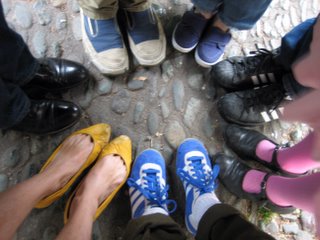 We Are Seven was a month long artist commune project, initiated by Grizedale Arts. Under the umbrella of Cumbriana Proof Grizedale's reintroduction of the Coniston Water Festival, Seven hip New York based artists were invited to reside at the world famous Wordworth Trust in Grasmere, Lake District. The Cumbriana Proof project was mostly to do with tourism so I think that it was interesting for Grizedale to invite the artists as artists/tourists, so that they could investigate these notions. However of course each artist came here with their own ideas of what the project/residency could be.
We Are Seven was a month long artist commune project, initiated by Grizedale Arts. Under the umbrella of Cumbriana Proof Grizedale's reintroduction of the Coniston Water Festival, Seven hip New York based artists were invited to reside at the world famous Wordworth Trust in Grasmere, Lake District. The Cumbriana Proof project was mostly to do with tourism so I think that it was interesting for Grizedale to invite the artists as artists/tourists, so that they could investigate these notions. However of course each artist came here with their own ideas of what the project/residency could be.During August 2005 the artists were to stay in cottages within the Wordsworth Trust grounds. However for two weeks it has to be said that due to unforeseen circumstances the accommodation was either inaccessible or unacceptable to the Seven. This shifted the focus and possible outcomes of the project. For the artists, living in the cottage and being within the Wordsworth Trust would have offered resources integral to their residency (And of course was the raison d etre of the residency) For Grizedale, an initial inten
 tion of the project was to position themselves as impartial observers of the Seven's ruptured conceptions of Grasmere as remote retreat. For The Trust itself, the focus was on the importance of the artist's participation within the organizational culture of the Wordsworth trust. All were thwarted in this first instance.
tion of the project was to position themselves as impartial observers of the Seven's ruptured conceptions of Grasmere as remote retreat. For The Trust itself, the focus was on the importance of the artist's participation within the organizational culture of the Wordsworth trust. All were thwarted in this first instance.It is easy to see why these artists took up this communal opportunity, but not so easy to decipher the internal and external wrangling which took place during this hot, heady summer. Each artist
came to the commune project with their own agendas but a common leitmotif was an interest in a reclamation and re-animation of the past. This could involve projecting identities onto the landscape and allowing the scenery of the Lake District and its surrounding cultures to feed into their responses in a flurry of existential activity. Alternatively this could mean enforced isolation and willed inactivity. The Romantic, idyllic retreat of poets Wordsworth, Coleridge et al seemed like the right place to be.

Rather than immersing themselves in group activities and work, they chose instead to approach the commune project as individual practitioners. They began researching their own existing projects, utilizing the Wordsworth Trust as a base rather than a location for visibly discursive artworks and activities. Their approach was not to ape the thought processes of tourists, taking in the scenery and waiting for elusive inspiration. Usually the freedom to develop ideas and discussions in any direction is a valid and exciting prospect. However without a clear direction or brief to begin with, (self-imposed or imposed from outside) it proved difficult for consistent lines of thought and inquiry to surface. Without expectations articulated, the members of We Are seven almost became victims, unsure of their purpose and paranoid about their potential artistic and discursive output. Thus a stalemate began, leaving dialogue and the space which was left for the group dynamic to develop publicly, difficult to negotiate. However a group dynamic did develop and it is this that I hope will be documented through this blog.
Of course things aren't always what they seem. Why take part in a project if you unsure of intentions? What did the project mean to the each participant? What did they get out of it? This blog is an attempt to document some of these goings on; plus explore and extend some of the witting and unwitting dialogues. Outlining collective activities and communal exercises. What was it all about, what did it all mean, where do we go from here? Perhaps I need to be clearer in my outlining of the project. Its just that I am not sure of all the why's, why not's and whatever's. Clarity may come through this blog. Stay tuned.
Documentation will include photos, text and audio-clips from the twice weekly meetings the Seven organized at The Wordsworth Trust Rotunda. Plus contributions from the Seven and other involved parties. Further examination will throw into sharp relief the protagonists, their friends and enemies. There will also be themed discussion forums with topics such as power, sex and the landscape and definitely some self-reflexivity and flagellation. It is hoped that themes will also be suggested by anyone who is interested in joining in with these discussions.
We Are Seven are Ian Cooper, Daphne Fitzpatrick, Rachel Foullon, K8 Hardy, Adam Putnam, Dana Sherwood, Allison Smith.
www.publicholidayprojects.comwww.notionnanny.net

0 Comments:
<< Home